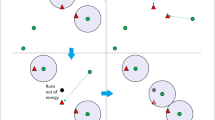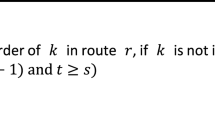Abstract
In this work we study the problem of collecting protected data in ad-hoc sensor network using a mobile entity called MULE. The objective is to increase information survivability in the network. Sensors from all over the network, route their sensing data through a data gathering tree, towards a particular node, called the sink. In case of a failed sensor, all the aggregated data from the sensor and from its children is lost. In order to retrieve the lost data, the MULE is required to travel among all the children of the failed sensor and to re-collect the data. There is a cost to travel between two points in the plane. We aim to minimize the MULE traveling cost, given that any sensor can fail. In order to reduce the traveling cost, it is necessary to find the optimal data gathering tree and the MULE location. We are considering the problem for the unit disk graphs and Euclidean distance cost function. We propose a primal–dual algorithm that produces a \(\left( 20+\varepsilon \right) \)-approximate solution for the problem, where \(\varepsilon \rightarrow 0\) as the sensor network spreads over a larger area. The algorithm requires \(O\left( n^{3}\cdot \varDelta \left( G\right) \right) \) time to construct a gathering tree and to place the MULE, where \(\varDelta \left( G\right) \) is the maximum degree in the graph and n is the number of nodes.




Similar content being viewed by others
References
Ashur, S.: Data gathering in faulty sensor networks using a mule. In: 34th European Workshop on Computational Geometry (EuroCG ’18) (2018). https://www.semanticscholar.org/paper/Data-Gathering-in-Faulty-Sensor-Networks-Using-a-Ashur/87fadb8a5148d56fa4fe5d6d8b572deb4ea51d26
Clark, B.N., Colbourn, C.J., Johnson, D.S.: Unit disk graphs. Discrete Math. 86(1), 165–177 (1990). https://doi.org/10.1016/0012-365x(90)90358-o
Crowcroft, J., Levin, L., Segal, M.: Using data mules for sensor network data recovery. Ad Hoc Netw. 40, 26–36 (2016). https://doi.org/10.1016/j.adhoc.2015.12.009
Dantzig, G.B., Ford, L.R., Fulkerson, D.R.: A primal-dual algorithm (1956). http://www.dtic.mil/dtic/tr/fulltext/u2/604972.pdf
Erlebach, T., Mihalák, M.: A (4+)-approximation for the minimum-weight dominating set problem in unit disk graphs. In: Approximation and Online Algorithms, pp. 135–146. Springer, Berlin (2010). https://doi.org/10.1007/978-3-642-12450-1_13
Goemans, M., Williamson, D.: A general approximation technique for constrained forest problems. SIAM J. Comput. 24(2), 296–317 (1995). https://doi.org/10.1137/s0097539793242618
Goemans, M.X., Williamson, D.P.: The primal-dual method for approximation algorithms and its application to network design problems (1997). http://www.math.uwaterloo.ca/~cswamy/courses/co453/w07/gw-pdsurvey.pdf
Levin, L., Efrat, A., Segal, M.: Collecting data in ad-hoc networks with reduced uncertainty. Ad Hoc Netw. 17, 71–81 (2014). https://doi.org/10.1016/j.adhoc.2014.01.005
Rao, S.B., Smith, W.D.: Approximating geometrical graphs via “spanners” and “banyans”. In: Proceedings of the Thirtieth Annual ACM Symposium on Theory of Computing—98. ACM Press (1998). https://doi.org/10.1145/276698.276868. http://citeseerx.ist.psu.edu/viewdoc/download?doi=10.1.1.51.8676&rep=rep1&type=pdf
Shah, R.C., Roy, S., Jain, S., Brunette, W.: Data mules: modeling a three-tier architecture for sparse sensor networks. In: Proceedings of the First IEEE International Workshop on Sensor Network Protocols and Applications 2003, 30–41 (2003). https://doi.org/10.1109/snpa.2003.1203354. http://ieeexplore.ieee.org/document/1203354/?reload=true
Somasundara, A.A., Ramamoorthy, A., Srivastava, M.B.: Mobile element scheduling for efficient data collection in wireless sensor networks with dynamic deadlines. In: IEEE International Real-Time Systems Symposium, 25th. IEEE (2004). https://doi.org/10.1109/real.2004.31. http://ieeexplore.ieee.org/abstract/document/1381316/
Williamson, D.P.: The primal-dual method for approximation algorithms. Math. Program. 91(3), 447–478 (2002). https://doi.org/10.1007/s101070100262
Wu, W., Du, H., Jia, X., Li, Y., Huang, S.C.H.: Minimum connected dominating sets and maximal independent sets in unit disk graphs. Theor. Comput. Sci. 352(1–3), 1–7 (2006). https://doi.org/10.1016/j.tcs.2005.08.037
Yedidsion, H., Banik, A., Carmi, P., Katz, M.J., Segal, M.: Efficient data retrieval in faulty sensor networks using a mobile mule. In: 2017 15th International Symposium on Modeling and Optimization in Mobile, Ad Hoc, and Wireless Networks (WiOpt), 15th, pp. 1–8. IEEE (2017). https://doi.org/10.23919/wiopt.2017.7959880. http://ieeexplore.ieee.org/abstract/document/7959880/
Zou, F., Wang, Y., Xu, X.H., Li, X., Du, H., Wan, P., Wu, W.: New approximations for minimum-weighted dominating sets and minimum-weighted connected dominating sets on unit disk graphs. Theor. Comput. Sci. 412(3), 198–208 (2011). https://doi.org/10.1016/j.tcs.2009.06.022
Acknowledgements
The research has been supported by Israel Science Foundation Grant No. 317/15 and the US Army Research Office under Grant #W911NF-18-1-0399.
Author information
Authors and Affiliations
Corresponding author
Additional information
Publisher's Note
Springer Nature remains neutral with regard to jurisdictional claims in published maps and institutional affiliations.
Appendix
Appendix
1.1 The Modification of Theorem 1 for the Case Where \(R_{M}\ge R\)
In this part we will describe the modification required in the proof of Theorem 1, for the case where \(R_{M}\) is constant such that \(R_{M}\ge R\). The only change required by our proposed algorithm is that the constant C in the node weights will be \(C=14.5\). That is, node weights in the remainder of the paper remain the same \(\left( 2\cdot dist\left\{ m^{*},v\right\} +C\right) \). This definition of C will guarantee the correctness of the rest of the paper, in partuclar Lemmas 12 and 13. Next, we show that the main argument of Theorem 1 still holds for this case. The main difference between this case and the case we describe in the paper (\({0<R_{M}<0.3R}\)) is in the \(\varepsilon \) formula and its conditions.
We claim that the total tour cost for a MULE located at m and for gathering tree T, \(Cost\left( T,m\right) \), can be bounded from above by the total weight of T’s BackBone nodes. Since a leaf node has no children in the tree T, the MULE does not go on tour for the failure of a leaf node. Therefore, the only nodes for which the tour cost \(c\left( t\left( m,\delta \left( v_{f},T\right) \right) \right) \) is greater than 0 are the BackBone nodes of T. So, we can write:
We consider the MULE’s transmission range as a constant \(R_{M}\ge R\). Let v be some node and \(c\left( t\left( m,\delta \left( v,T\right) \right) \right) \) be its tour cost. Since this is an UDG, v’s furthest child from the MULE m is at most \(dist\left\{ m,v\right\} +1\) units away. Hence, if \(dist\left\{ m,v\right\} +1\le R_{M}\) then when a failure occurs the MULE has no need to move at all and the tour cost is 0. In case \(dist\left\{ m,v\right\} +1>R_{M}\), the MULE can walk forth and back exactly \(dist\left\{ m,v\right\} -R_{M}+1\) units in the direction of v, in order to cover all of its children and to complete the tour (Fig. 5). Let us define the positive constant \(C_{2}\triangleq C-2+2R_{M}\). The addition of \(C_{2}\) to the tour cost only increases it. Formally, it can be put as follows:
So if we put the two equations together, we get:
Let us define \(D_{m,v}\triangleq dist\left\{ m,v\right\} -R_{M}-1\), and let \(H\left( \cdot \right) \) be the Heaviside step function:
Next, consider node weights \(\left[ \left( dist\left\{ m,v\right\} -R_{M}-1\right) \cdot H\left( D_{m,v}\right) \right] \). Then the \(Cost\left( T,m\right) \) can be bounded from below by the total weight of T’s BackBone nodes. Note that the shortest tour to a particular failed node v is in case the node has exactly one child in T, which is located as close as possible to the MULE. Since this is only one child, then \(WAC\left( v,T\right) =0\). We will distinguish between two possible cases. If \(dist\left\{ m,v\right\} -1\le R_{M}\), then only this child is within the MULE’s transmission range and therefore \(LWF\left( v,T\right) =LWB\left( v,T\right) =0\). Otherwise \(dist\left\{ m,v\right\} -1>R_{M}\), and, thus, the MULE must walk exactly \(dist\left\{ m,v\right\} -R_{M}-1\) units (Fig. 6) to get close enough to the child and return. In this case \(LWF\left( v,T\right) =LWB\left( v,T\right) =dist\left\{ m,v\right\} -R_{M}-1\). Let us write this in one equation:
Therefore we can bound the MULE’s tour from below, as follows:

By combining this with Eq. 27, we have:
Now we can claim that the total weight of the optimal solution to the MWCDS problem with node weights \(\left( 2\cdot dist\left\{ m^{*},v\right\} +C\right) \) (\(OPT_{cds^{*}}\)), is an \(\left( 1+\varepsilon \right) \)-approximation to the cost of the optimal solution for the \(\left( 1,1\right) -MULE-UDG\) problem (\(OPT_{T^{*}}\)). Recall that \(cds^{*}\) is the optimal solution to this MWCDS problem and \(V_{BB}^{*}\) is the BackBone nodes of the optimal gathering tree, where \(m^{*}\) is the MULE location. From Eq. 9 of Theorem 1, we know that holds:
From the calculations in the previous paragraphs, we already know that:
Let us define a partition of the BackBone nodes into \(V_{D}^{*}\triangleq \left\{ v\in V_{BB}^{*}\,:\,D_{m^{*},v}>0\right\} \) and \(\overline{V_{D}^{*}}\triangleq \left\{ v\in V_{BB}^{*}\,:\,D_{m^{*},v}\le 0\right\} \). Since set \(\overline{V_{D}^{*}}\) is defined for nodes with \(D_{m^{*},v}\le 0\), then by definition of \(D_{m^{*},v}\) this requires that \({dist\left\{ m,v\right\} -R_{M}-1\le 0}\), so it can be said that:
We define \(\underset{v\in V_{D}^{*}}{Average}\left[ dist\left\{ m^{*},v\right\} \right] \) to be the average distance of the BackBone nodes in \(V_{D}^{*}\) from the MULE. Now we calculate the ratio between the upper bound to the optimal solution.
where, \(\varepsilon \triangleq \left( R_{M}+13.25\right) \cdot \left( 1+\frac{\left| \overline{V_{D}^{*}}\right| }{\left| V_{D}^{*}\right| }\right) \cdot \left( \underset{v\in V_{D}^{*}}{Average}\left[ dist\left\{ m^{*},v\right\} \right] -\left( R_{M}+1\right) \right) ^{-1}\). When the graph is deployed over a wide area with a radius significantly greater than \(R_{M}\), \(\left| V_{D}^{*}\right| >\left| \overline{V_{D}^{*}}\right| \), and since \(R_{M}\) is a constant, then the error \(\varepsilon \rightarrow 0\) for \({\underset{v\in V_{D}^{*}}{Average}\left[ dist\left\{ m^{*},v\right\} \right] \rightarrow \infty }\). We should note that for correct approximation, set \(V_{D}^{*}\) must contain at least one node. To summarize it all together in one equation:
Rights and permissions
About this article
Cite this article
Zur, Y., Segal, M. Improved Solution to Data Gathering with Mobile Mule. Algorithmica 82, 3125–3164 (2020). https://doi.org/10.1007/s00453-020-00718-2
Received:
Accepted:
Published:
Issue Date:
DOI: https://doi.org/10.1007/s00453-020-00718-2






